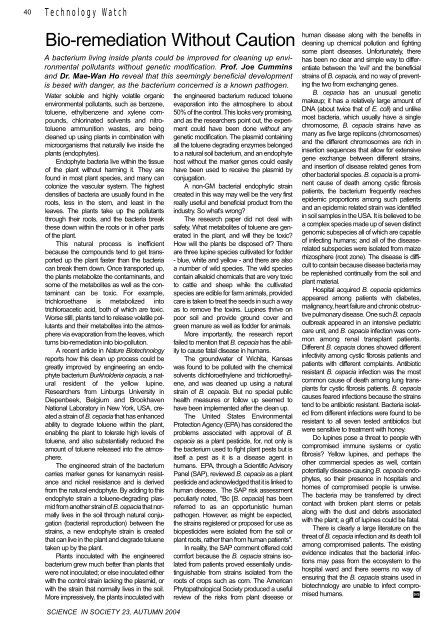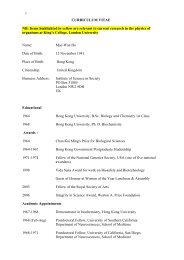Ethiopia goes organic to feed herself - The Institute of Science In ...
Ethiopia goes organic to feed herself - The Institute of Science In ...
Ethiopia goes organic to feed herself - The Institute of Science In ...
You also want an ePaper? Increase the reach of your titles
YUMPU automatically turns print PDFs into web optimized ePapers that Google loves.
40<br />
Technology Watch<br />
Bio-remediation Without Caution<br />
A bacterium living inside plants could be improved for cleaning up environmental<br />
pollutants without genetic modification. Pr<strong>of</strong>. Joe Cummins<br />
and Dr. Mae-Wan Ho reveal that this seemingly beneficial development<br />
is beset with danger, as the bacterium concerned is a known pathogen.<br />
Water soluble and highly volatile <strong>organic</strong><br />
environmental pollutants, such as benzene,<br />
<strong>to</strong>luene, ethylbenzene and xylene compounds,<br />
chlorinated solvents and nitro<strong>to</strong>luene<br />
ammunition wastes, are being<br />
cleaned up using plants in combination with<br />
microorganisms that naturally live inside the<br />
plants (endophytes).<br />
Endophyte bacteria live within the tissue<br />
<strong>of</strong> the plant without harming it. <strong>The</strong>y are<br />
found in most plant species, and many can<br />
colonize the vascular system. <strong>The</strong> highest<br />
densities <strong>of</strong> bacteria are usually found in the<br />
roots, less in the stem, and least in the<br />
leaves. <strong>The</strong> plants take up the pollutants<br />
through their roots, and the bacteria break<br />
these down within the roots or in other parts<br />
<strong>of</strong> the plant.<br />
This natural process is inefficient<br />
because the compounds tend <strong>to</strong> get transported<br />
up the plant faster than the bacteria<br />
can break them down. Once transported up,<br />
the plants metabolize the contaminants, and<br />
some <strong>of</strong> the metabolites as well as the contaminant<br />
can be <strong>to</strong>xic. For example,<br />
trichloroethane is metabolized in<strong>to</strong><br />
trichloroacetic acid, both <strong>of</strong> which are <strong>to</strong>xic.<br />
Worse still, plants tend <strong>to</strong> release volatile pollutants<br />
and their metabolites in<strong>to</strong> the atmosphere<br />
via evaporation from the leaves, which<br />
turns bio-remediation in<strong>to</strong> bio-pollution.<br />
A recent article in Nature Biotechnology<br />
reports how this clean up process could be<br />
greatly improved by engineering an endophyte<br />
bacterium Burkholderia cepacia, a natural<br />
resident <strong>of</strong> the yellow lupine.<br />
Researchers from Linburgs University in<br />
Diepenbeek, Belgium and Brookhaven<br />
National Labora<strong>to</strong>ry in New York, USA, created<br />
a strain <strong>of</strong> B. cepacia that has enhanced<br />
ability <strong>to</strong> degrade <strong>to</strong>luene within the plant,<br />
enabling the plant <strong>to</strong> <strong>to</strong>lerate high levels <strong>of</strong><br />
<strong>to</strong>luene, and also substantially reduced the<br />
amount <strong>of</strong> <strong>to</strong>luene released in<strong>to</strong> the atmosphere.<br />
<strong>The</strong> engineered strain <strong>of</strong> the bacterium<br />
carries marker genes for kanamycin resistance<br />
and nickel resistance and is derived<br />
from the natural endophyte. By adding <strong>to</strong> this<br />
endophyte strain a <strong>to</strong>luene-degrading plasmid<br />
from another strain <strong>of</strong> B. cepacia that normally<br />
lives in the soil through natural conjugation<br />
(bacterial reproduction) between the<br />
strains, a new endophyte strain is created<br />
that can live in the plant and degrade <strong>to</strong>luene<br />
taken up by the plant.<br />
Plants inoculated with the engineered<br />
bacterium grew much better than plants that<br />
were not inoculated; or else inoculated either<br />
with the control strain lacking the plasmid, or<br />
with the strain that normally lives in the soil.<br />
More impressively, the plants inoculated with<br />
SCIENCE IN SOCIETY 23, AUTUMN 2004<br />
the engineered bacterium reduced <strong>to</strong>luene<br />
evaporation in<strong>to</strong> the atmosphere <strong>to</strong> about<br />
50% <strong>of</strong> the control. This looks very promising,<br />
and as the researchers point out, the experiment<br />
could have been done without any<br />
genetic modification. <strong>The</strong> plasmid containing<br />
all the <strong>to</strong>luene degrading enzymes belonged<br />
<strong>to</strong> a natural soil bacterium, and an endophyte<br />
host without the marker genes could easily<br />
have been used <strong>to</strong> receive the plasmid by<br />
conjugation.<br />
A non-GM bacterial endophytic strain<br />
created in this way may well be the very first<br />
really useful and beneficial product from the<br />
industry. So what's wrong?<br />
<strong>The</strong> research paper did not deal with<br />
safety. What metabolites <strong>of</strong> <strong>to</strong>luene are generated<br />
in the plant, and will they be <strong>to</strong>xic?<br />
How will the plants be disposed <strong>of</strong>? <strong>The</strong>re<br />
are three lupine species cultivated for fodder<br />
- blue, white and yellow - and there are also<br />
a number <strong>of</strong> wild species. <strong>The</strong> wild species<br />
contain alkaloid chemicals that are very <strong>to</strong>xic<br />
<strong>to</strong> cattle and sheep while the cultivated<br />
species are edible for farm animals, provided<br />
care is taken <strong>to</strong> treat the seeds in such a way<br />
as <strong>to</strong> remove the <strong>to</strong>xins. Lupines thrive on<br />
poor soil and provide ground cover and<br />
green manure as well as fodder for animals.<br />
More importantly, the research report<br />
failed <strong>to</strong> mention that B. cepacia has the ability<br />
<strong>to</strong> cause fatal disease in humans.<br />
<strong>The</strong> groundwater <strong>of</strong> Wichita, Kansas<br />
was found <strong>to</strong> be polluted with the chemical<br />
solvents dichloroethylene and trichloroethylene,<br />
and was cleaned up using a natural<br />
strain <strong>of</strong> B. cepacia. But no special public<br />
health measures or follow up seemed <strong>to</strong><br />
have been implemented after the clean up.<br />
<strong>The</strong> United States Environmental<br />
Protection Agency (EPA) has considered the<br />
problems associated with approval <strong>of</strong> B.<br />
cepacia as a plant pesticide, for, not only is<br />
the bacterium used <strong>to</strong> fight plant pests but is<br />
itself a pest as it is a disease agent in<br />
humans. EPA, through a Scientific Advisory<br />
Panel (SAP), reviewed B. cepacia as a plant<br />
pesticide and acknowledged that it is linked <strong>to</strong><br />
human disease. <strong>The</strong> SAP risk assessment<br />
peculiarly noted, "Bc [B. cepacia] has been<br />
referred <strong>to</strong> as an opportunistic human<br />
pathogen. However, as might be expected,<br />
the strains registered or proposed for use as<br />
biopesticides were isolated from the soil or<br />
plant roots, rather than from human patients".<br />
<strong>In</strong> reality, the SAP comment <strong>of</strong>fered cold<br />
comfort because the B. cepacia strains isolated<br />
from patients proved essentially undistinguishable<br />
from strains isolated from the<br />
roots <strong>of</strong> crops such as corn. <strong>The</strong> American<br />
Phy<strong>to</strong>pathological Society produced a useful<br />
review <strong>of</strong> the risks from plant disease or<br />
human disease along with the benefits in<br />
cleaning up chemical pollution and fighting<br />
some plant diseases. Unfortunately, there<br />
has been no clear and simple way <strong>to</strong> differentiate<br />
between the 'evil' and the beneficial<br />
strains <strong>of</strong> B. cepacia, and no way <strong>of</strong> preventing<br />
the two from exchanging genes.<br />
B. cepacia has an unusual genetic<br />
makeup; it has a relatively large amount <strong>of</strong><br />
DNA (about twice that <strong>of</strong> E. coli) and unlike<br />
most bacteria, which usually have a single<br />
chromosome, B. cepacia strains have as<br />
many as five large replicons (chromosomes)<br />
and the different chromosomes are rich in<br />
insertion sequences that allow for extensive<br />
gene exchange between different strains,<br />
and insertion <strong>of</strong> disease related genes from<br />
other bacterial species. B. cepacia is a prominent<br />
cause <strong>of</strong> death among cystic fibrosis<br />
patients, the bacterium frequently reaches<br />
epidemic proportions among such patients<br />
and an epidemic related strain was identified<br />
in soil samples in the USA. It is believed <strong>to</strong> be<br />
a complex species made up <strong>of</strong> seven distinct<br />
genomic subspecies all <strong>of</strong> which are capable<br />
<strong>of</strong> infecting humans; and all <strong>of</strong> the diseaserelated<br />
subspecies were isolated from maize<br />
rhizosphere (root zone). <strong>The</strong> disease is difficult<br />
<strong>to</strong> contain because disease bacteria may<br />
be replenished continually from the soil and<br />
plant material.<br />
Hospital acquired B. cepacia epidemics<br />
appeared among patients with diabetes,<br />
malignancy, heart failure and chronic obstructive<br />
pulmonary disease. One such B. cepacia<br />
outbreak appeared in an intensive pediatric<br />
care unit, and B. cepacia infection was common<br />
among renal transplant patients.<br />
Different B. cepacia clones showed different<br />
infectivity among cystic fibrosis patients and<br />
patients with different complaints. Antibiotic<br />
resistant B. cepacia infection was the most<br />
common cause <strong>of</strong> death among lung transplants<br />
for cystic fibrosis patients. B. cepacia<br />
causes feared infections because the strains<br />
tend <strong>to</strong> be antibiotic resistant. Bacteria isolated<br />
from different infections were found <strong>to</strong> be<br />
resistant <strong>to</strong> all seven tested antibiotics but<br />
were sensitive <strong>to</strong> treatment with honey.<br />
Do lupines pose a threat <strong>to</strong> people with<br />
compromised immune systems or cystic<br />
fibrosis? Yellow lupines, and perhaps the<br />
other commercial species as well, contain<br />
potentially disease-causing B. cepacia endophytes,<br />
so their presence in hospitals and<br />
homes <strong>of</strong> compromised people is unwise.<br />
<strong>The</strong> bacteria may be transferred by direct<br />
contact with broken plant stems or petals<br />
along with the dust and debris associated<br />
with the plant; a gift <strong>of</strong> lupines could be fatal.<br />
<strong>The</strong>re is clearly a large literature on the<br />
threat <strong>of</strong> B. cepacia infection and its death <strong>to</strong>ll<br />
among compromised patients. <strong>The</strong> existing<br />
evidence indicates that the bacterial infections<br />
may pass from the ecosystem <strong>to</strong> the<br />
hospital ward and there seems no way <strong>of</strong><br />
ensuring that the B. cepacia strains used in<br />
biotechnology are unable <strong>to</strong> infect compromised<br />
humans.<br />
SiS











